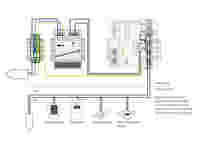Every automation system needs sensors in order to function. Sensors are the components that record important status information and convert and transmit this information in the form of electrical signals. Sensors detect analog values such as room temperature, humidity, brightness and weather data, or digital values such as switch positions and sensor pulses. When designing automated control of building functions, you should carefully consider which factors should be allowed to influence the control – this choice will determine the sensors required.
Actuators receive the data telegrams and convert them into actions, like switching and dimming commands for lights, control commands for blinds, awnings, etc. or setting commands for heating element valves. For example, if the temperature is too low, the valve on the heating element can be opened to warm the room. Typical actuators include valves, servo drives and LED drivers.

